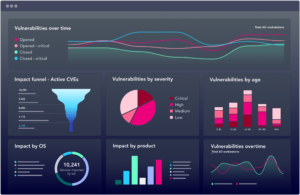In an attempt to tackle the limitations of traditional Vulnerability Management (VM) solutions, which only discover and report on CVEs, Risk-Based Vulnerability Management (RBVM) was designed to ingest the vulnerability assessment data, correlate additional weighting attributes such as CVSS and EPSS to aid prioritization based on these factors.
Although RBVM does provide several benefits over a traditional VM tool, it still takes a siloed, singular viewpoint of the attack surface that doesn’t consider additional exposure types, such as misconfigurations, identity issues, poor cyber hygiene, and weak security posture. RBVM also still treats each device as a singular entity, and calculates its scoring with limited context, or awareness of the broader surroundings and interconnectivity of resources across the enterprise network.
XM Cyber takes a more holistic approach. Guided by the principles of CTEM and leveraging XM Cyber Attack Graph Analysis™, we consider all exposures and prioritize them based on exploitability in YOUR environment and how likely they are to lead to critical assets, not just generic severity. XM Cyber helps security stakeholders reach beyond standard RBVM – beyond just patching to proactively defend against ever-evolving cyber threats.
Understanding Risk-Based Vulnerability Management
RBVM (Risk-Based Vulnerability Management) is a cybersecurity strategy designed to help security stakeholders prioritize the most dangerous vulnerabilities, rather than patching every single one. RBVM analyzes how critical the affected systems are and the likelihood of attackers exploiting them, based on their individual context. This helps security teams focus remediation efforts on the most at-risk devices, typically being the ones that present the greatest intrusion-risk, minimizing potential breach points in their attack surface.
RBVM does this by prioritizing vulnerabilities (CVEs), based on the potential exploitability of each CVE, the severity that may result, and the number of CVEs present on the individual device. It augments vulnerability data with analytics based on the Common Vulnerability Scoring System (CVSS), the Exploit Prediction Scoring System (EPSS), and in some instances the asset criticality, with threat intelligence sources to prioritize those issues that have been known to be or predicted to be exploited. Essentially, RBVM tools analyze each vulnerability’s potential impact on your organization. This considers factors like how critical the impacted system is, and if the vulnerability is listed on the Known Exploited Vulnerability (KEV) catalog, which tracks CVEs known to be exploited by attackers. Although RBVM is a vast improvement over traditional VA and VM tools, it still draws attention to the worst offending devices, that are demanding urgent patching, rather than highlighting the weakest links in your security posture that can go unnoticed to security defenders, but present the greatest opportunities to attackers.
The Limitations of Traditional Vulnerability Management
While RBVM tools provide prioritization of vulnerabilities on known devices – which helps clarify the next most likely breach point – the results delivered by RBVM systems still yield an unmanageable list of issues. Moreover, just because a vulnerability has been exploited in the wild does not mean it can be exploited in every environment or configuration, or that it opens an attack path to a critical asset. In fact, most exposures are not on an attack path to critical assets.
Moreover, because RBVM risk ranking is based on CVE data and threat context, yet does not take into account the impact risk they present to business critical systems , analysts like Gartner have concluded that “…prioritized lists alone are rarely enough to mobilize non security teams and remediate the issues due to insufficient business context and accountability considerations.”
This is why the capabilities of RBVM need to be extended to incorporate additional exposure attributes, asset context and validation logic, in order to become a true Exposure Management solution. Exposure Management solutions like XM Cyber, excel at identifying a wide range of security weaknesses, including vulnerabilities, misconfigurations, identity and credential issues. Taking an RBVM-like approach to prioritization, but with the added exposure attributes, provides a far more accurate ranking system of risk across the hybrid attack surface.
By combining RBVM with Exposure Management, organizations gain a comprehensive understanding of their security posture. Exposure Management provides a complete picture of all potential weaknesses, while RBVM prioritizes the most critical vulnerabilities based on potential impact. This combined approach ensures that security teams are not overwhelmed by a never-ending list of vulnerabilities, but rather focus on patching the ones that could be most easily exploited and have the most significant consequences. Ultimately, this unified strategy strengthens an organization’s overall defense against cyber threats by addressing the weaknesses that attackers are most likely to target.
XM Cyber: Elevating Vulnerability Management with Attack Path Analysis
As discussed, RBVM traditionally relies on identifying and prioritizing patching for known weaknesses (CVEs). XM Cyber takes a proactive leap forward leveraging Attack Path Analysis. This strategy goes beyond identifying individual exposure issues and validates their exploitability using real-world attack techniques to uncover the true risk they present to you organization, and the opportunity they provide to your adversaries, through the eyes of the attacker themselves.
XM Cyber’s Attack Graph Analysis(™) maps the available routes attackers could exploit to reach critical assets. These attack paths represent the various ways an attacker could gain access to sensitive information or critical systems. By analyzing these paths, XM Cyber prioritizes all forms of exposure, including vulnerabilities, based on their role in an attack scenario. Correlating all possible attack paths, across your hybrid infrastructure, within the XM Platform, identifies key intersections where multiple attack paths converged, and highlights them as “Choke Points” to further prioritize remediation efforts.
For instance, a high-severity CVE in a system with strong access controls might be less critical than a seemingly minor misconfiguration that creates a direct path to a critical asset. This prioritization ensures security teams focus on the weaknesses attackers are most likely to exploit, significantly reducing overall risk. Using the XM Attack Graph Analysis(™) translates into tangible, real-world benefits:
- Reduced risk – By addressing exposures within attack paths, organizations directly tackle the weaknesses attackers target, leading to a significant decrease in overall risk.
- Improved efficiency – Security teams spend less time patching vulnerabilities that wouldn’t be helpful to attackers. They can focus their efforts on the most critical issues, maximizing the impact of their work.
- Actionable insights – XM Cyber provides remediation playbooks tailored to the identified weaknesses. This empowers security teams to take the most appropriate and effective action to close those security gaps.
XM Cyber empowers organizations to see their network through the attacker’s perspective. They can identify choke points – critical intersections where multiple attack paths converge. By prioritizing these choke points, organizations can significantly disrupt an attacker’s strategy and make it much harder to breach their defenses. This proactive, holistic approach to vulnerability management allows organizations to move beyond just patching vulnerabilities and elevate their overall cybersecurity posture.
| Feature | Traditional RBVM | XM Cyber Continuous Exposure Management |
| Focus | Prioritizes vulnerabilities (CVEs) based on risk | Analyzes all security exposures and attack paths |
| Exposure Types | Primarily CVEs | CVEs, misconfigurations, identity and credential issues. |
| Attacker Perspective | Minimal | Considers attacker perspective and potential exploitation routes |
| Prioritization | Based on individual vulnerability severity and asset criticality | Based on the role of the vulnerability within attack paths, the compromise rate, and the potential business impact risk |
| Efficiency | May patch vulnerabilities attackers wouldn’t exploit | Focuses remediation efforts on vulnerabilities presenting the greatest risk to critical assets |
| Actionable Insights | Minimal guidance on remediation | Provides easy to follow step-by-step remediation playbooks and best practice security guides |
| Overall Approach | Reactive – focuses on patching identified vulnerabilities | Proactive – identifies vulnerabilities and validates their exploitability along attack paths to you critical assets |
| Risk Reduction | Reduces intrusion-risk by addressing high-severity vulnerabilities | Combines intrusion-risk with business impact risk, to drive a significant reduction in overall risk posture. |
XM Cyber empowers security stakeholders to extend RBVM’s prioritization logic to include other exposure risks (misconfigurations, weak security posture, identity issues and more) and provides actionable, custom-tailored remediation playbooks. With XM Cyber, you can see your environment through the eyes of the attacker, to identify the key intersections where multiple attack paths converge, and prioritize remediation efforts by focusing on the issues that present the most risk to your business.
From Patching to Proactive Defense: The Power of CTEM for RBVM
While RBVM offers a valuable approach to prioritizing vulnerabilities, it has limitations.
Its focus on CVEs leaves other security gaps unaddressed, and its static assessments might miss emerging threats. XM Cyber’s Attack Graph Analysis(™) bridges this gap, empowering organizations to see their network through an attacker’s eyes and prioritize weaknesses based on exploitability.
CTEM acts as a powerful force multiplier for RBVM strategies. By offering continuous monitoring, enhanced prioritization, actionable insights, and a focus on building cyber resilience, CTEM transforms a reactive patching approach into a proactive, continuous defense against ever-evolving cyber threats. CTEM builds upon RBVM’s foundation, adding continuous monitoring, enhanced threat prioritization, actionable insights, and a focus on building cyber resilience. This holistic approach transforms security from a reactive patching exercise into a proactive, continuous defense against ever-evolving threats. By aligning with business goals and adapting to the changing threat landscape, CTEM empowers organizations to not just survive, but thrive in today’s complex cybersecurity environment.
To learn more about how XM Cyber can enhance and extend your existing RBVM stack, read more here.





